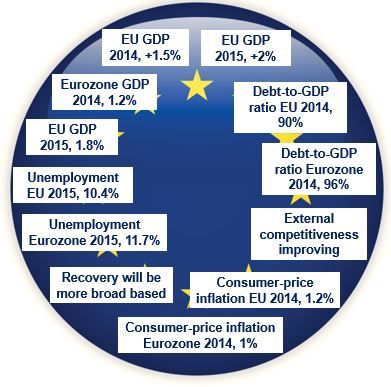The European economy is gaining ground, says the European Commission, though not at the same rates or strengths in all countries.
The consequences of debt and fiscal consolidation from the financial crisis and Great Recession, however, mean that the economic rebound will continue to be a fragile and tenuous one.
The economic outlook for both the Eurozone and the whole EU (European Union) has improved significantly since the Commission’s last forecast in the autumn of 2013.
For the whole of the EU, GDP growth for 2013 was 0.1%.
The Commission forecasts 1.5% growth for 2014 and 2% for 2015. For just the Eurozone, forecasts for 2014 and 2015 are slightly lower, 1.2% and 1.8% respectively, i.e. the non-euro area countries within the EU are doing much better than those within the Eurozone.
(Data source: European Commission)
European economic recovery will be less lopsided
The European economic recovery is expected to become more broad-based across all Member States in 2014, with nations on the Eurozone periphery, the more vulnerable ones, beginning to strengthen.
The EU’s economy will still be uneven, with the northern nations registering more stable figures and better economic growth. However, the gap between the best performing countries and those with problems will narrow.
Only Slovenia and Cyprus have negative GDP growth forecasts for 2014, and by 2015 there will not be any EU nations with negative outlooks.
Domestic demand expected to strengthen in 2014
Olli Rehn, Commission Vice-President for Economic and Monetary Affairs and the Euro said:

“Recovery is gaining ground in Europe, following the return to growth in the middle of last year. The strengthening of domestic demand this year should help us to achieve more balanced and sustainable growth.”
“Rebalancing of the European economy has been progressing and external competitiveness is improving, particularly in the most vulnerable countries.”
“The worst of the crisis may now be behind us, but this is not an invitation to be complacent, as the recovery is still modest. To make the recovery stronger and create more jobs, we need to stay the course of economic reform.”
The unemployment problem will persist
Unemployment is not expected to improve significantly this year or in 2014, and neither is the labor market in general. This is because there is a lag in response to an economic recovery, as well as the overall moderate recovery in the EU. There is a lag because companies try to get to full capacity before taking on more employees.
Levels of unemployment in the Eurozone are expected to stabilize in 2014, followed by a slight reduction in 2015, to approximately 10.4% in the EU and 11.7% in the Eurozone. The non-euro area of the EU has significantly lower unemployment rates than the Eurozone.
There will still be enormous differences in unemployment rates within the EU, with Austria predicted to have 4.8% of its adult population without work in 2014, compared to 26% in Greece.
Inflation may continue its downward trend
Inflation declined considerably in 2013, thanks to falling commodity and energy prices, weak internal demand and a rising euro. Low consumer-price inflation is predicted to continue falling in 2014, standing at 1.2% in the EU and 1% in the Eurozone.
Reductions in public spending in the EU have been considerable. However, the worst is over in most Member States – during the rest of the forecast period no significant reductions to public budgets are planned. In the Eurozone, the debt-to-GDP ratio is expected to peak in 2014 at 96%, and at 90% in the EU.
According to the Markit Economic Limited, Eurozone business growth continued to gain strength in February.


